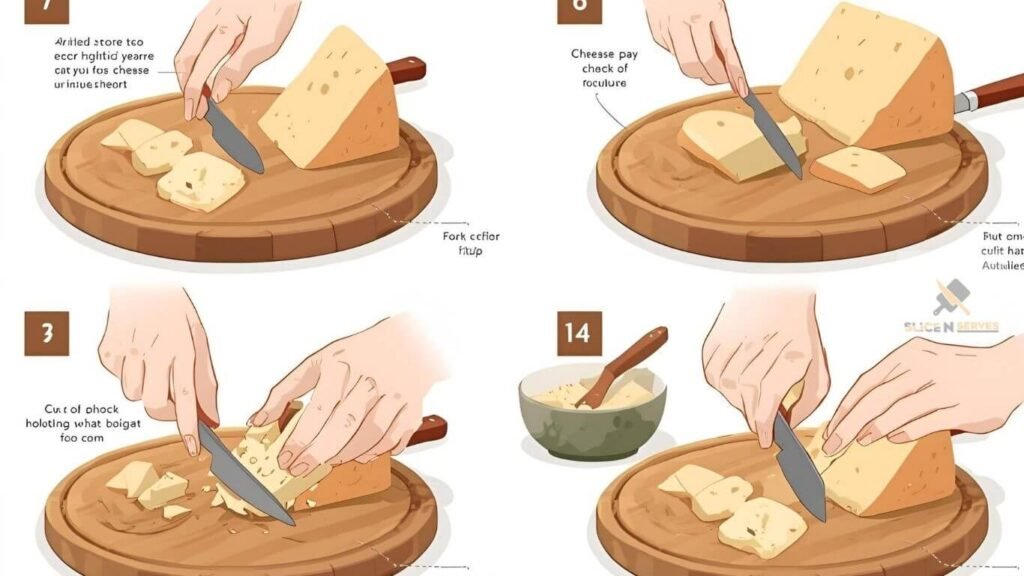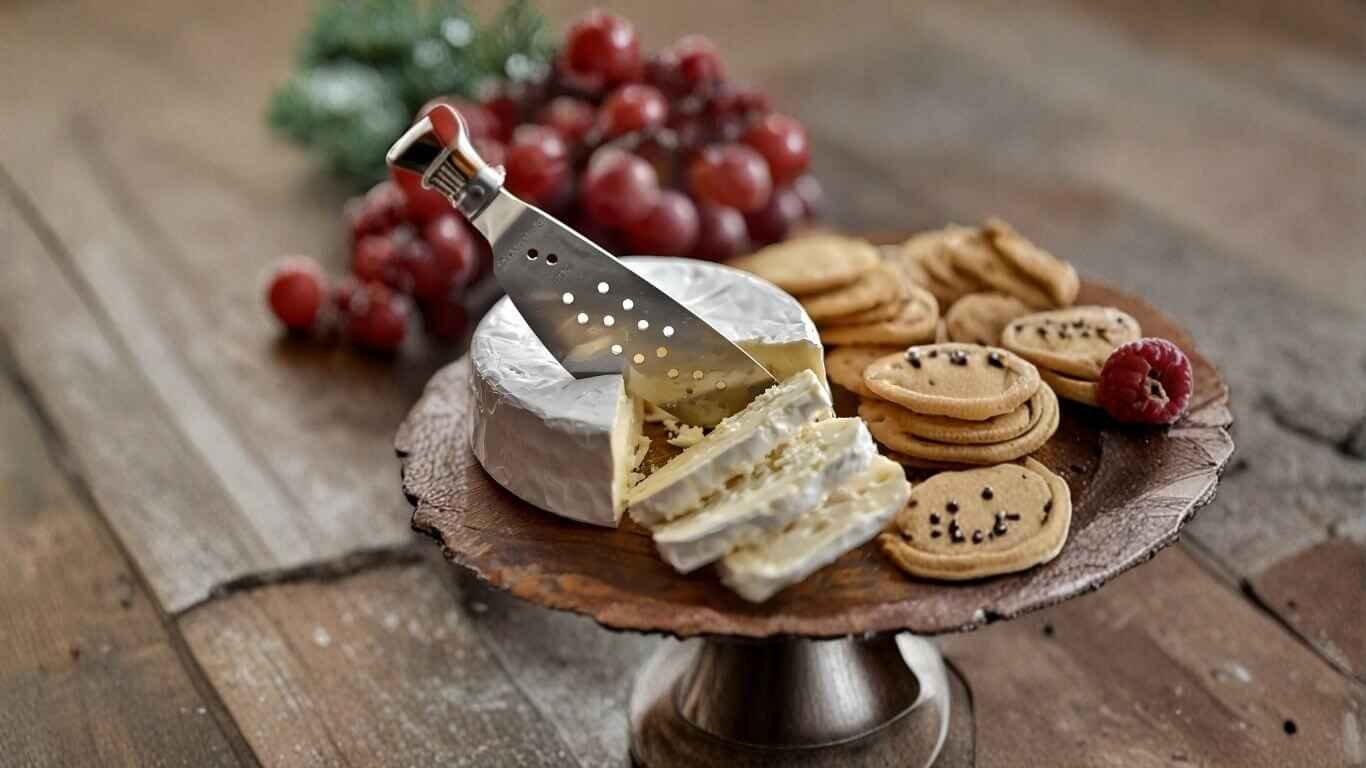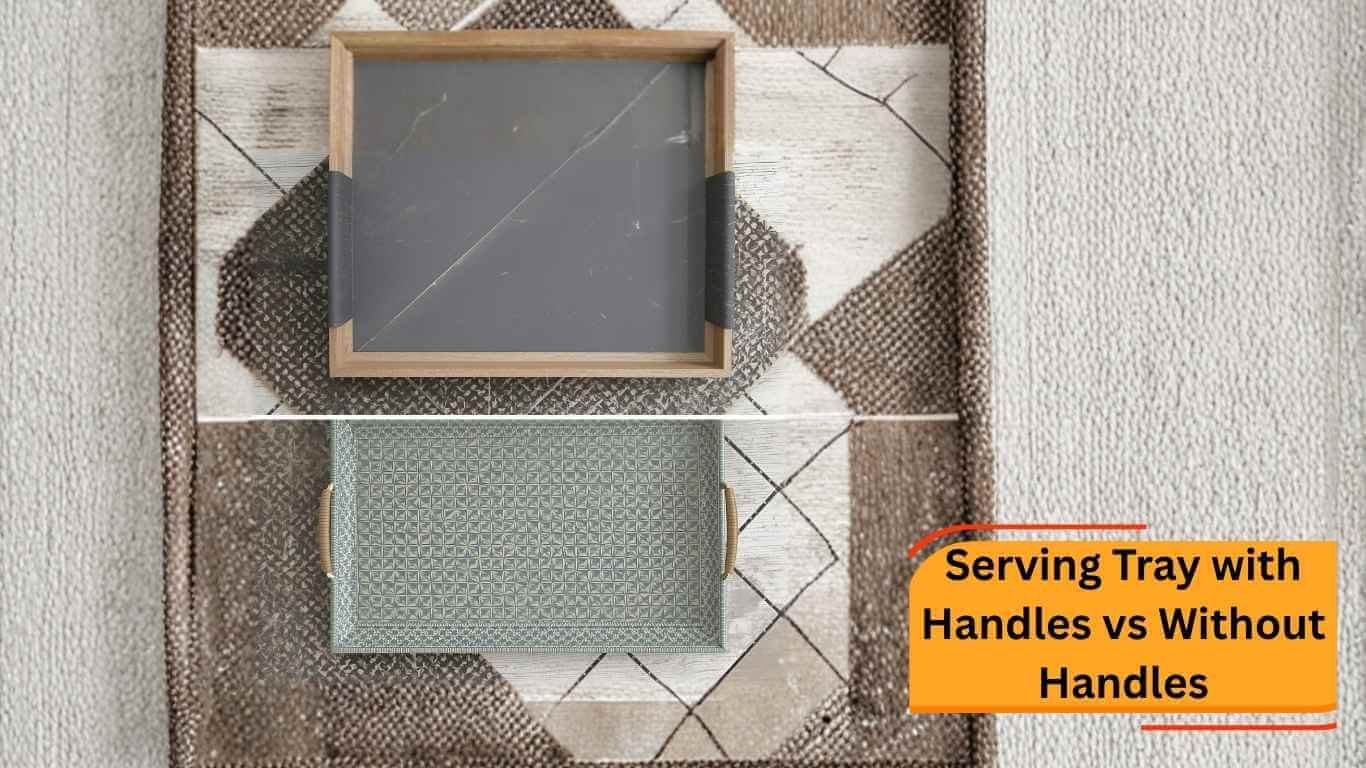A well-crafted charcuterie board is a symphony of tastes, textures, and colors, with cheese as its star. But beyond selecting high-quality cheeses, the art of presentation lies in the cut. You can transform a simple platter into a visually stunning masterpiece by slicing, cubing, or crumbling your cheese. Cheese consumption is expected to reach a record 42 pounds per person in 2023, making mastering these techniques more important than ever. It will walk you through everything you need to know, from the essential tools to specific cutting methods, so you can make your next cheese board as beautiful and delicious as possible
Beyond Basic Bites: Elevating Your Cheese Presentation
An elevated experience begins with moving beyond simply placing a block of cheese on a board. Cheese cuts that are thoughtfully shaped do more than just look good; they make it easier for guests to serve themselves, encourage tasting, and can even enhance the tasting experience by altering the surface area of the cheese and how it interacts with their palates. By varying shapes and sizes, the eye is guided across the board and the entire spread is more visually appealing.
What Makes a Cheese Cut “Visually Stunning”?
A visually stunning cheese cut enhances the board’s aesthetic while respecting the cheese’s unique characteristics. It involves three key elements: variety, precision, and intention. Combining sharp triangles, uniform cubes, elegant slices, and rustic crumbles creates dynamic contrast. Precision ensures clean lines and consistent sizes, which indicate care and quality. Lastly, intention means that each cut is chosen to complement the cheese’s texture and make pairing with crackers and fruits effortless.
Your Essential Tool Kit: Mastering Cheese Knives for Perfect Cuts
Tools are not a luxury; they are necessary for achieving clean, professional-looking cuts. The wrong knife can crush a delicate cheese or fail to penetrate a hard cheese, resulting in a messy presentation. A beautifully curated set of cheese knives is the foundation of any great charcuterie board.
The Right Blade for Every Cheese: A Guide to Knife Selection
Every cheese has its own density, texture, and shape, which determines the best tool for the job. From soft, creamy Brie to hard, crystalline Parmesan, specific knives are designed to handle them with finesse. By understanding which blade to use, you can avoid sticking, crumbling, and frustration, allowing each cut to be executed flawlessly.
Soft Cheese Knives: For Brie, Camembert, and Fresh Chevre
The softness of cheese makes it prone to sticking and compressing. A soft cheese knife is designed to combat this with features such as a thin blade and perforations (holes) that reduce surface area, allowing the knife to glide through creamy textures like goat cheese or Brie without dragging. For perfect wedges, the delicate structure must remain intact.
Hard Cheese Knives: Cleavers and Parmesan Knives for Dense Blocks
Power and precision are required when grating hard cheeses like Parmesan, aged cheddar, or Manchego. Small, spade-shaped Parmesan knives are designed to cut rustic, bite-sized chunks from dense blocks. When scoring and splitting hard cheese, a small, sharp cleaver provides the leverage needed without shattering it.
Spreading Knives: For Creamier Spreads and Delicate Cheeses
Spreading knives (or spatula knives) are essential for spreading very soft, spreadable cheeses like fresh mozzarella in water, mascarpone, or creamy Boursin. With its dull, rounded blade, it is perfect for spreading cheese onto crackers without tearing the bread or cracker.
Thin Blade Cheese Knives and Cheese Planes: Achieving Uniform Slices
The best way to slice semi-hard cheeses like Gouda and Havarti uniformly is with a cheese plane or a thin blade knife. Using a cheese plane, you can shave off thin, even slices, which are perfect for layering or fanning out on a board. A thin, sharp knife can achieve a similar effect, allowing you to control the thickness.
Pronged Cheese Knife: For Serving with Grace
In addition to being a charcuterie board workhorse, this knife is often called a fork-tipped spear. For cutting semi-hard cheeses like cheddar, it features a sharp blade and a forked tip for easy picking up and serving. Because of its dual functionality, it is an excellent all-around tool for both cutting and serving.
Chisel Knives: For Crumbly Textures and Artistic Shapes
It’s ideal to use a flat chisel knife for crumbly cheeses such as blue cheese and aged Gouda. The tool can be used to break off pieces vertically or to make horizontal slices from a block. Its wide, flat shape makes it ideal for creating both rustic crumbles and more defined shapes.
Sharpening and Care: Ensuring Clean, Effortless Cuts
There is nothing worse for a cheesemonger than a dull knife. It will crush the cheese rather than slice it, ruining its texture. Follow the manufacturer’s instructions when it comes to sharpening your knives. To prevent corrosion and maintain their integrity for years to come, hand-wash them with warm, soapy water and dry them immediately after use.
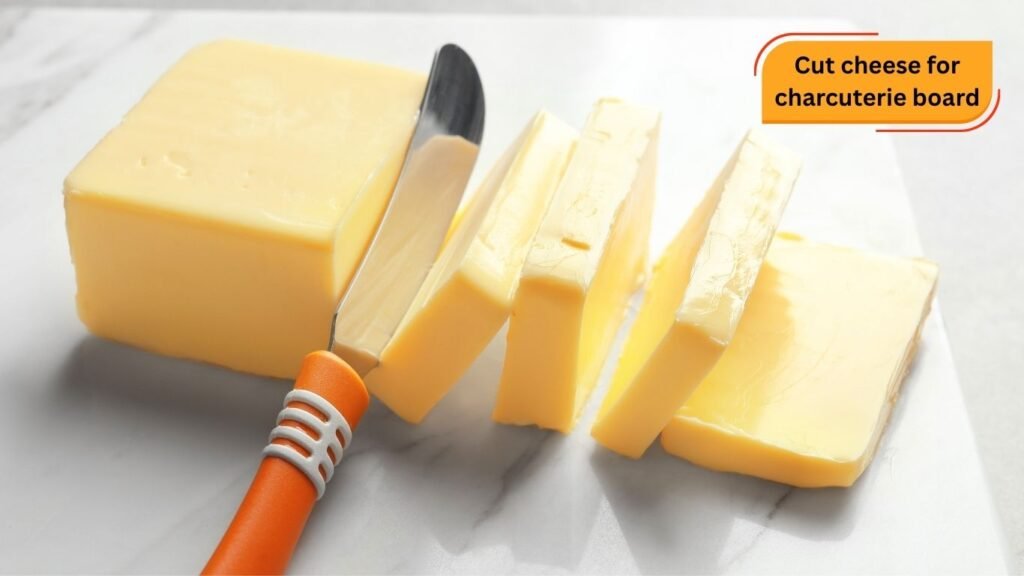
The Foundation of Flawless Presentation: General Cutting Principles
Understanding a few key principles before making your first cut will ensure success. For a cheese board to look professional, clean, and appealing, these fundamentals apply to nearly every type of cheese.
Optimal Cheese Temperature: Why It Matters for Clean Cuts
The temperature is everything. Hard cheeses can be cut more easily when they are close to room temperature, since they are less brittle at that temperature. When cheeses like goat cheese or Brie are well-chilled, they are much easier to handle; the cold firms them up, making them less likely to ooze or stick to knives. You should remove hard cheeses from the fridge 30 minutes before cutting, and soft cheeses just before cutting.
The Importance of Sharpness: Preventing Crushing and Unevenness
The most important tool in your arsenal is a sharp knife. Dull blades require more pressure, which damages the delicate paste of the cheese, especially soft varieties. With a sharp, clean edge, you can create precise, aesthetically pleasing shapes, whether you’re making a thin slice or a perfect cube.
Hygiene First: Using Kitchen Gloves for Pristine Handling
Consider wearing disposable kitchen gloves for a truly professional look. Besides ensuring better food safety, it also prevents fingerprints and smudges on the cheese. Keep the cheese looking pristine and appetizing for your guests by handling it as little as possible.
Embracing the Rind: How to Showcase and Present Natural Cheese Rinds
Many cheeses have a rind that contributes flavor and texture. Most rinds can be eaten, unless they are made of wax or cloth. Make sure each slice of cheese has a proportionate amount of rind when cutting cheeses like Brie or Manchego. As a result, guests have the option of tasting the cheese and a complete, authentic appearance of the cheese is presented.
Variety is the Spice of Life: Mixing Shapes and Textures for Visual Interest
Monotony is the result of a board with only one shape. By cutting cheese into different shapes, you can create visual excitement. Combine sharp triangles of Manchego with neat cubes of cheddar and rustic crumbles of blue cheese. Not only does this variety look great, but it also subtly guides guests on how to approach each cheese. As consumers appreciate curated experiences, the artisanal cheese market is forecast to grow 7% by 2025 thanks to this attention to detail.
Cutting by Category: Specific Techniques for Different Cheese Types
Each cheese family presents its own challenges and opportunities. By focusing on the texture and shape of each variety on your board, you will be able to present them in the best possible way.
Fresh & Soft Cheeses: Delicate Handling for Visually Appealing Forms
There is a delicate and high moisture content to cheeses like fresh mozzarella or goat cheese. You can create perfect, clean round slices of goat cheese using unflavored dental floss or a thin wire instead of a knife. If you want a more rustic appearance, you can slice, cube, or tear fresh mozzarella into rustic pieces.
Bloomy Rind Cheeses: Preserving Elegance (Brie, Camembert)
Brie or Camembert wheels should be cut like cakes for best results. Slice it into long, thin wedges, beginning at the center and working outward. It ensures a balanced ratio of flavorful rind to creamy interior in every serving. To prevent paste from sticking to the knife, always use a soft cheese knife.
Semi-Hard Cheeses: Versatility in Cubes, Slices, and Wedges (Cheddar, Gouda, Havarti, Swiss, Manchego)
There is no doubt that this is the most versatile category. For a block of cheddar, you can create uniform cubes for snacking or thin rectangular slices for crackers. You can slice wedges of Gouda or Manchego into thin triangles, sometimes called “flags,” by cutting perpendicular to the thinnest edge. Each piece of rind is beautifully highlighted by this method.
Hard & Aged Cheeses: Rustic Shards, Crumbles, and Robust Cuts (Parmesan, Aged Cheddar, Gruyère)
Cheeses that are hard and aged are not meant to be sliced perfectly. Rustic approaches are best for showcasing their crystalline, crumbly texture. By scoring the block with a Parmesan knife, you can gently pry off bite-sized shards or crumbles. As a result, the natural texture of the cheese is embraced, which makes for an inviting, rugged presentation.
Blue Cheeses: Handling Crumbly Delicacy with Grace (Gorgonzola, Blue Jay)
Due to its crumbly nature, blue cheese can be tricky to work with. It is best to cut firm blues into wedges if they are firm. When serving creamier cheeses like Gorgonzola, it is best to leave the wedge whole and provide a knife for guests to use themselves. Make crumbles or small, carefully cut cubes with a sharp, thin knife if you prefer to pre-cut.
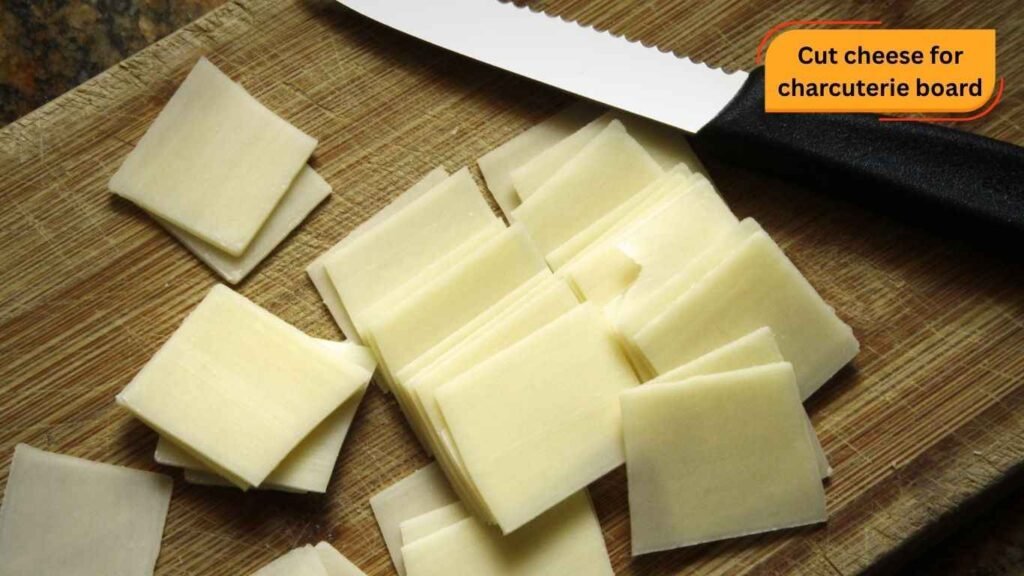
Advanced Techniques for an “Instagram-Worthy” Charcuterie Board
Once you’ve mastered the basics, you can elevate your cheese board from great to unforgettable with a few advanced techniques. Professional, artistic touches are added to these methods.
The Fanned-Out Slice: Creating Dynamic Visual Flow
When it comes to semi-hard cheeses like Gouda or cheddar, don’t just stack them up. Instead, fan them out in a gentle curve or in a straight, overlapping line. By using this technique, guests can easily pick up a single slice of the board, adding movement and elegance.
Ribbon Cuts and Rosettes: Unexpected Elegance for Softer Semi-Hards
Using a cheese plane or vegetable peeler, shave off long, thin strips from pliable cheeses like young provolone or Havarti. They can be folded into ribbons or rolled into delicate rosettes. Adding a cheese rosette to your arrangement adds a touch of sophistication and a stunning focal point.
Strategic Crumbles: Enhancing Texture and Volume with Intentional Placement
Don’t just scatter crumbles of blue cheese or aged cheddar at random. Create a flowing “river” that winds between other elements on the board, or arrange them neatly in a pile. As a result of this intentional placement, the board looks organized and abundant while also adding texture and volume.
Showcasing Artistic Rinds: Presenting the Natural Beauty of the Cheese Edge
There are some cheeses that have beautiful, unique rinds, such as the patterned rind on Manchego and the ash-dusted rind on Morbier. If you are cutting these cheeses, make sure the rinds are visible and celebrated. Create a conversation piece by cutting wedges or triangles in a way that highlights these artistic details.
Conclusion
The art of creating a visually stunning charcuterie board starts with a simple collection of cheeses. If you master a variety of cuts – from simple cubes and wedges to elegant ribbons and rosettes – as well as the unique properties of each cheese, you can create a spread that delights the palate and captivates the eyes.
Managing temperature, using sharp tools, and embracing variety in shapes and textures are the foundational principles. Global cheese consumption is expected to reach $283.10 billion by 2032, so these skills will make you stand out. At the end of the day, you want your cheese board to be more than just food. If you plan to share it with others, it should be beautiful, inviting, and easy to do so.
